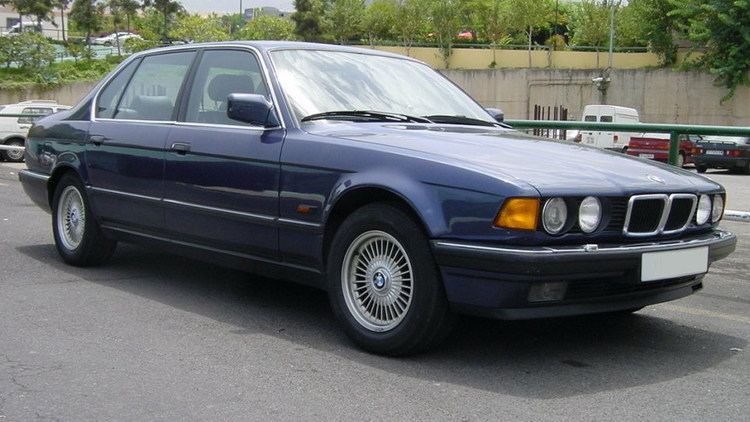Manufacturer BMW | ||
 | ||
Production 1986–1994311,068 built Class Full-size luxury car (F) Body style 4-door sedan/saloon4-door extended sedan/saloon | ||
The E32 is a BMW 7 Series luxury car. After almost 7 years in development since September 1979, in July 1986, BMW introduced the car as a replacement for the E23. Aimed at the high end of the luxury market, the car offered some of the latest innovations in automotive technology, and (beginning in 1987) a new, top-of-the-line V12 engine. First BMW featuring EDC III Electronic Damper Control. Some luxury options featured on the E32 included integrated telephone and fax machines, a wine cooler, double glazing, Automatic Stability Control + Traction (ASC+T) traction control system, and a system that automatically increased spring pressure on the windscreen wipers to keep them firmly pressed on the glass at Motorway speeds. The E32 (750i) was the first car adhering to BMW's self-imposed speed limit of 250 km/h (155 mph).
Contents
- 750iL Highline
- 767iL Goldfish prototype
- Powertrain
- Engines specifications and performance
- Design and Legacy
- Related cars
- References
In 1991, world first series production low beam Xenon high-intensity discharge headlamps (Litronic, only low beam) were introduced on the 750iL.
The car was also available in a stretched version (indicated by an 'L' from German Lang, after the model number), in which case an extra 11.4 centimetres (4.5 in) of leg room was available to the rear passengers by stretching the rear doors, and the body at this point.
The styling is credited to then-chief stylist Ercole Spada and Hans Kerschbaum working under the guidance of then-chief designer Claus Luthe. Design work began in late 1979, in which by 1983 1:1 scale models were presented and frozen in 1984 for 1986 production.
Production of the BMW E32 series concluded in 1994 with a total of 311,068 units built.
750iL Highline
The BMW 750iL Highline was the top-of-the-line model of the E32, with lots of added luxury for the rear passengers like full leather, dual radio controls, dual climate control with coolbox mounted in the center console, electrically heated and adjustable rear seats, walnut veneer folding tables, two crystal glasses neatly placed in the coolbox, legrests, and sun shade all around the rear/side windows. Complete with independent heating and ventilation, it also added a second battery in the trunk and a second alternator to provide power for all these luxuries. The 'Highline' option package cost more than 20,000 DEM (€10,000 equivalent), and was only available on the 750iL, bringing the total price to well over twice that of a 'basic' 730i ('basic' to be taken in context).
767iL Goldfish prototype
The 767iL Goldfish was a single prototype of E32 car powered with V16 engine. It was conceived in 1987 and built by the end of 1988. Because of the length of the engine, the cooling system (radiator) was moved to the trunk and additional vents were added at the rear.
Powertrain
The E32 7-series cars were offered with 5 gasoline engines.
At the car's introduction, the 730 and 735 used the straight-6 M30 engine, while the 750 featured the all-new M70 V12 engine which produced 300 bhp (224 kW; 304 PS).
In 1992, a new 32-valve V8 engine was introduced, the M60. The 730i got this engine in a 3-liter version, while the new 740i got the 4-liter version. Both versions were coupled to a new, 5-speed automatic transmission made by ZF.
In some countries (notably in the USA and UK), there were problems with the M60 engine because of excessive sulfur amount in gasoline, causing corrosion problems in its Nikasil cylinder block. The cylinder lining would quickly wear, causing the engine to lose compression, which caused rough idling and eventually the engine would fail to start. Engines were replaced under warranty; the problem was corrected by using a different material, Alusil. In the USA and UK sulfur rich fuel is being phased out. Nikasil engines are unlikely to be a problem today, as cars with affected engines are off the road or have received replacement engines.
Externally, the BMW 'kidney' grille indicated which engine was present under the hood: all 6-cylinder models had a narrow grille, and all 8- and 12-cylinder models had the wider version. This feature was not seen on later models (the E38 used a wide grille for all models). The narrow grille was available as an option on the 8- and 12-cylinder E32 models.
The 740i speed was electronically limited at 240 km/h (149 mph) to distinguish it from the flagship vehicle 750i. The 740i E38 which used the same engine as 740i E32 had speed limited to 250 km/h (155 mph).
Engines specifications and performance
Design and Legacy
The E32 was the first BMW that brought the L-Shape tail-lights into the company's design line-up. This was intended for safety and security from the rear view of the car. The next generation 7-Series the E38 slightly drifted away from this in terms of design aspect with its more blocky tail-lights, although the amber indicator light in connection with the red brake lights clearly did form a smaller L-shape as well. It wasn't until the introduction of the F01 7-Series that this design aspect was truly revived.
Related cars
The E34 5 series, introduced in 1988, has design cues similar to the E32, and some engines and other parts are shared between the two cars.
The E31 8 series features some of the same engines as the E32: M60 V8 and M70 V12.
